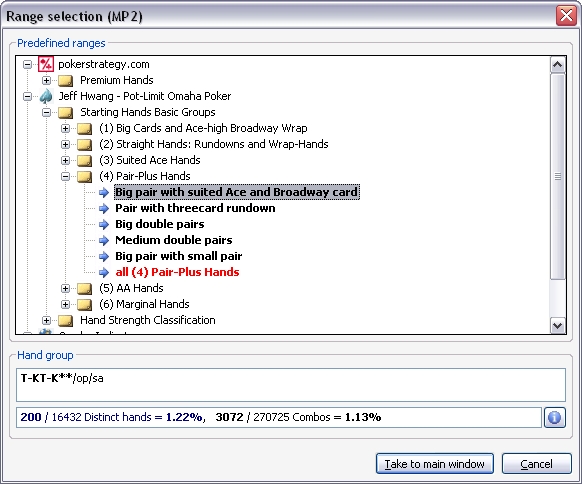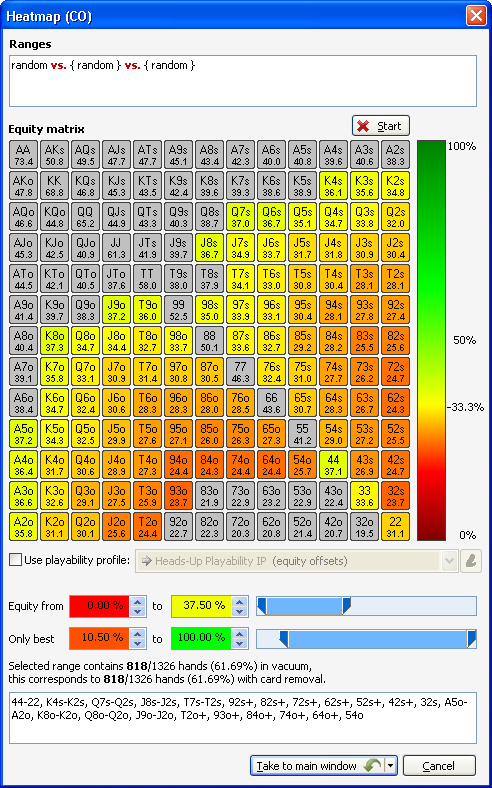Equilab Poker
It is time to get little geek and technical here. So what are stats and what does HUD stands for ?
Stats are statistic of all the players you are playing against online. They are collected with dedicated software and displayed on the table to give you information. Way they are displayed on the table is called HUD (Heads Up Display). Most of the top professionals nowadays are using HUD. There are few companies that make the similar software with al the statistics that help you gain more information about you opponent. Two most popular and widespread software are “Holdem Manager” and “Poker Tracker“. They are both made by a different companies and have subtle differences but you can find all the most important statistics in both of them and in many other similar programs.
Description How To Use Equilab (Free Poker Equity Calculator) Poker Quick Plays Our software tool gives you the ability to analyse the equity against a specific hand or against a range of hands. On top of that, you can also check your equity in any given scenario, thanks to the various filters you can use. You can select and visualize a range of hands in equity evaluation software, such as Equilab. This software is a used, when you are studying poker away from the table. Over time, you will automatically know your equity with different hands in different situations. Selecting and visualizing a range of hands in Equilab.
Do I need HUD ?
Ok so there are a ton of numbers next to the players but what does all that mean ? Do I need all that ? This is my personal HUD that I made to meet my personal needs and preferences. Maybe you don’t need all that, and maybe you need more. Maybe you do not need HUD at all! Some famous and very successful players played without the HUD and made tons of money.
Famous online grinder Samoleus did not use the HUD, but he is not playing online for almost 10 years now. Patrick Antonius Finnish poker super star is one of the biggest all time online winners. He did not use HUD also but did not have many success online for years. He mostly switched to live cash games and tournaments with great results. One of the most famous online grinders Randy Lew “Nanonoko” also played without stats but he retired few years ago.
Game evolved a lot. Many players improved. It is tougher than ever so every little edge you can gain you should go for it. So can you win a live poker game without using poker tells ? Maybe if all your other poker skills are top notch but why not gain that extra edge by learning body language and poker tells ? Same goes for using HUD and online play.
VPIP

First most basic and most important stat is VPIP (voluntary put money into pot). So when you are in big blind and there is no raise and you decide to check that will not count in your VPIP. Any other time you decide to limp,call or raise that goes in VPIP stat. So player who is playing every hand has a VPIP 100%. Hope that makes some sense. But what if player has VPIP of 25 or 12 ? How can you make some useful information out of that ? Some basic common sense will lead you to conclusion that first player is playing more than twice as much hands as player two but what exact hands he is playing ?
It is very easy to determinate what hands are in for example 12% of hands. For that you need a very simple software developed by guys from PokerStrategy called “Equilab” and you can download it for free from here.
Equilab
Equilab Poker Calculator

So what is this software used for ? Equilab is used to calculate your equity ( statistical chance of wining a hand). So you can put in 2 different hands and calculate you equity. And you can also put your hand against range of hands. Range is a term used to describe group of possible hands. When you progress in your poker thinking you will always think in ranges. Rarely in exact hands. For example you know your opponent is a tight player. And he reraise you. Can you say he has two kings or two queens or AK ? NO! You can not. You can put him on a range not on specific hand for example : AA,KK,QQ,AK. So these 4 hands are his range in that situation. And lets say you have TT in that situation. So what is your chance of wining in that example ?
So by putting these hands in the software we can see that TT vs this range has 36% change of winning.
Ok now that we understand what is range and how is this software used lets get back to to VPIP and determining what hands is our opponent holding. In our previous example we have a player with VPIP 12. So if you just click on the first icon to pick range and put in 12 we can see what exact hands are mathematically 12% of all hands
Do not blindly use default Equilab range
So these are hands our opponent is playing. Can we be certain he is playing these exact hands ? No because equilab gave us 12% of strongest hands. Maybe for example our opponent does not like playing AJ and instead of that hand he has QJ or some other one that will still be 12%. So we can not be 100% certain but it give us some idea and some very useful information. The same way we can determine what is 25% or any other VPIP or other stats.
Conclusion
So stats, Hud, Equilab and statistics are one big part of poker. This is a big area for improvement and learning. Since this is just a basic article with some basic principles I did not dig deeper into the stats and i mentioned only VPIP for now to make it suitable for beginners. In a future articles I will try to cover all the important stats and ways to use them to gather information. For now I would suggest to get a holdem manager, poker tracker or other software and add hud to your tables. Start paying attention to your opponents vpip and how involved they are. Download equilab and play with different vpip ranges and try to memorize what hands are in which range.
Also check my live play video for more instructions here.
Good luck 😉

Imagine, that you are dealt JJ in the big blind. It is folded to an opponent, who goes all in with the remains of his stack from the small blind. You are last to act. What is your chance of winning here? The answer depends on your ability to evaluate your equity in this situation.
Putting opponent on a range
Your equity at this point in the hand depends on the hands, that your opponent will be going all in with for the remains of his stack. This qualified assumption will not just be a specific hand, but a whole range of hands. Your assumption will be based on the type of opponent, that you are facing, and other information, that you might have. This proces is also known as putting your opponent on a range.
The range of hands, that your opponent will have in this situation, will depend on the player type of your opponent. It might also depend on his perception of your player type.
In this example, you might know or assume, that your opponent is a tight player type, who does this with a range of hands, that includes AA, KK, QQ, AK and AQ. This range is also described as QQ+, AQ+.
Evaluating equity
You can select and visualize a range of hands in equity evaluation software, such as Equilab. This software is a used, when you are studying poker away from the table. Over time, you will automatically know your equity with different hands in different situations.
Your equity, with your hand against the range of hands of your opponent, can then be evaluated.

In this example, JJ has a 42,60% chance to win the hand. JJ is not a favorite to win the hand.
Conclusion

Equilab Poker Android
Your ability to evaluate and know your equity is a fundamental element of poker. It is crucial to your long term results.
Equilab Poker Calculator
When evaluating your chances of winning at a given time in a poker hand, you will use your ability to assume a range of hands, that your opponent will have. You can then visualize that range in equity evaluating software and calculate your equity against that range.
Whether or not you should raise, call or fold depends on other factors as well. These factors includes the pot odds, that you given in the hand, and the expected value.